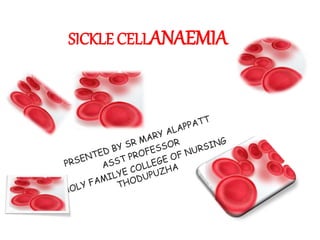Sickle cell anemia is an inherited blood disorder where red blood cells become rigid and sticky and are shaped like sickles or crescents. This causes them to get stuck in small blood vessels and block blood flow, leading to pain crises. It is caused by a genetic mutation that results in abnormal hemoglobin called hemoglobin S. Symptoms include anemia, pain crises, swelling in hands and feet, and increased risk of infections. Complications can include stroke, organ damage, pulmonary hypertension, and blindness if untreated. Treatment focuses on pain management, antibiotics to prevent infection, hydroxyurea to reduce crises, blood transfusions, and potentially a bone marrow transplant for cure. Nursing care centers on managing pain












































